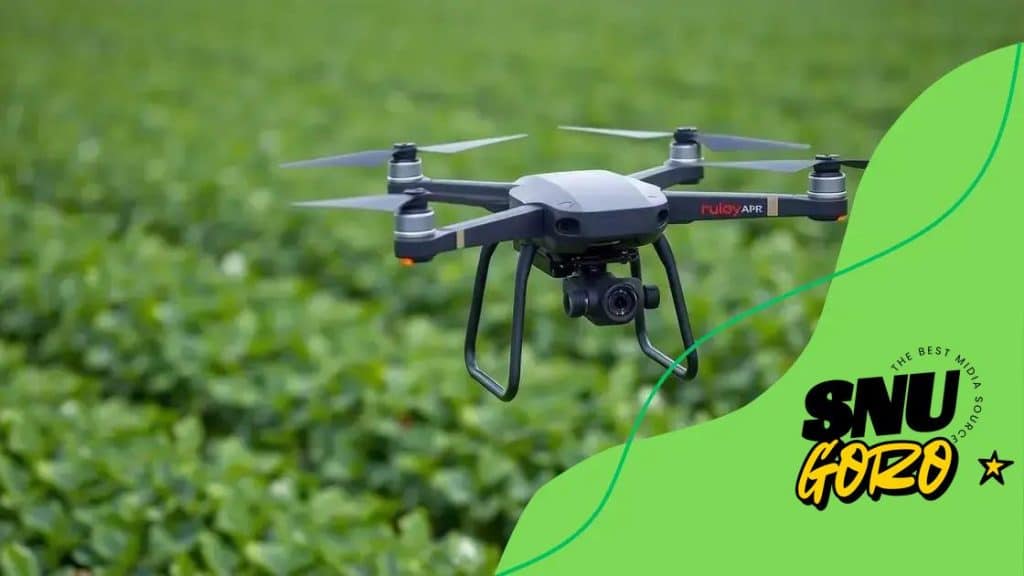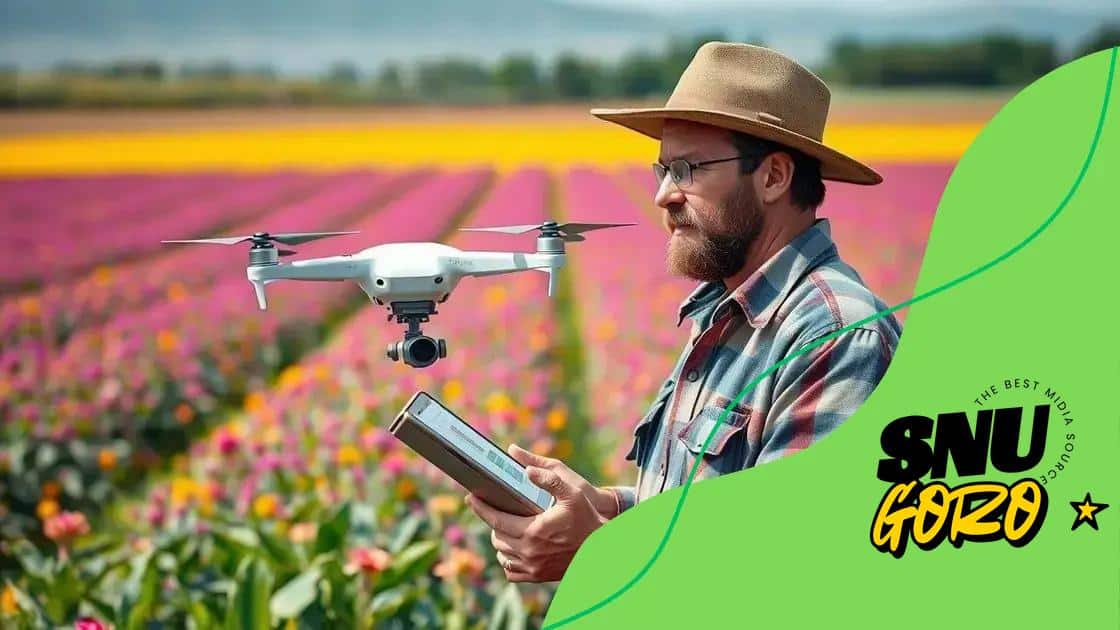Smart agriculture and drone technology: transforming farming

Smart agriculture and drone technology enhance farming by enabling precise monitoring, resource management, and automation, leading to greater efficiency, sustainability, and crop yields.
Smart agriculture and drone technology are changing the landscape of modern farming. Have you ever wondered how these innovations can optimize crop monitoring and resource management? Let’s dive into their impact and potential!
understanding smart agriculture
Understanding smart agriculture is essential for anyone interested in the future of farming. This innovative approach combines technology with traditional farming practices. With smart agriculture, farmers can improve their efficiency and sustainability.
What is smart agriculture?
Smart agriculture includes techniques that use technology to enhance farming. This means using sensors, data analytics, and artificial intelligence to optimize crop production.
Key components of smart agriculture
- IoT devices: These devices collect data from the field, such as soil moisture and temperature.
- Data analysis: Farmers analyze this data to make informed decisions about irrigation and fertilization.
- Automation: Automation helps streamline various farming tasks, reducing the need for manual labor.
- Precision farming: This technique targets specific areas within a field to use resources more efficiently.
By integrating smart technologies, farmers gain valuable insights. These insights lead to better management of resources, resulting in higher yields and reduced waste. For example, with data-driven decisions, a farmer can decide the best time to plant, irrigate, or apply pesticides.
Additionally, smart agriculture promotes sustainability. By using less water and fewer chemicals, farmers minimize their environmental impact. This means that not only are they producing more food, but they are also caring for the planet.
In conclusion, understanding smart agriculture is key to embracing the future of farming. The combination of technology and agriculture opens new avenues for efficiency and sustainability.
the role of drone technology in farming
The role of drone technology in farming is transforming how farmers manage their fields. Drones provide real-time data that helps with better decision-making. By integrating drone technology, farmers can monitor their crops with precision.
Benefits of using drones
Drones offer several key benefits that enhance agricultural practices. They allow for quick assessments of large areas, which is vital in modern farming.
- Aerial surveying: Drones can capture detailed images of fields, enabling farmers to identify issues like pest infestations or nutrient deficiencies.
- Crop monitoring: Farmers can track plant health over time using drone images, making it easier to apply necessary treatments.
- Efficient spraying: Drones can be equipped with sprayers for pesticides and fertilizers, allowing for precise application and reducing waste.
- Soil analysis: Drones can help analyze the soil condition, which supports better crop selection and planting strategies.
Moreover, the use of drones is time-saving. Instead of walking through fields, farmers can use drone technology to survey crops and gather information that would take much longer manually. As a result, farmers can spend more time on strategic planning and farming practices.
In addition, drones enhance sustainability. By applying fertilizers and pesticides only where needed, they minimize unnecessary chemical use. This careful approach benefits both the environment and crop productivity, leading to healthier harvests.
Using drones in agriculture represents a shift toward smarter farming practices. As technology continues to advance, one can expect broader adoption and even greater efficiencies in farming.
benefits of integrating drones in agriculture

Integrating drones in agriculture offers numerous benefits that are transforming the farming landscape. With drones, farmers can achieve a higher level of efficiency and productivity.
Enhanced crop monitoring
One of the primary advantages is enhanced crop monitoring. Drones can quickly survey large areas and collect data about crop health. This information allows farmers to spot problems early and take action before issues escalate.
- Real-time data: Drones provide immediate insights, enabling quick decision-making.
- High-resolution images: Capturing images from above helps identify pests, disease, and nutrient deficiencies.
- Reduced labor: Manual inspections are time-consuming, so drones save valuable labor hours.
- Regular updates: Drones can fly over crops frequently, ensuring farmers stay informed about their fields.
Moreover, the use of drones leads to improved resource management. By analyzing the data collected, farmers can optimize their inputs, such as water, fertilizers, and pesticides. This helps in minimizing waste and costs.
Drones also enhance precision agriculture techniques. Farmers can apply inputs more accurately, targeting specific areas that need attention rather than a blanket application over the entire field. This tailored approach increases yield while reducing environmental impact.
In addition, using drones promotes better agricultural practices. Drones can conduct soil analysis and monitor crop performance continuously. This data-driven approach allows farmers to rotate crops effectively and manage fields more sustainably.
By integrating drones, farmers not only increase their operational efficiency but also support long-term sustainability in agriculture.
challenges faced by farmers with drone adoption
Farmers face several challenges when adopting drones in their agricultural practices. Although drone technology offers many benefits, the transition can be difficult for some.
Cost of implementation
One major challenge is the initial cost of purchasing and maintaining drones. While prices have been decreasing, the investment can still be significant for small-scale farmers.
- Equipment costs: High-quality drones and sensors can be expensive, putting a strain on budgets.
- Training expenses: Farmers may need to invest in training programs to learn how to operate drones effectively.
- Maintenance costs: Regular maintenance and repairs can add additional expenses over time.
Moreover, regulatory hurdles can complicate drone use in agriculture. Farmers must adhere to local laws regarding drone operations. These regulations can limit flight altitude, operational areas, and types of data collection.
Weather conditions can also pose challenges for farmers using drones. Rain, high winds, and extreme temperatures can interfere with drone functionality. Drones may not be able to operate efficiently in adverse weather, which can delay important monitoring tasks.
Some farmers may also struggle with technological adoption. Transitioning to a technology-driven approach requires a change in mindset. Education and support are crucial in helping farmers understand how to leverage drones effectively.
Lastly, data management can be overwhelming. Drones collect vast amounts of data that farmers need to analyze. Without the right tools or knowledge, making sense of this data can become a daunting task that hinders the benefits associated with drones.
future trends in smart agriculture and drone technology
The future of smart agriculture and drone technology holds exciting possibilities. As technology advances, these tools will play a crucial role in shaping farming practices. Farmers are expected to rely more on data-driven insights for decision making.
Increased automation
One major trend is the rise of automation. Drones will not only monitor crops but also perform tasks like planting seeds and applying fertilizers. This will save time and significantly reduce labor costs.
- Autonomous drones: Future drones will operate without constant human control, increasing efficiency.
- Robotics integration: Drones may work alongside robotic systems for a fully automated farm.
- Advanced AI: Artificial intelligence will analyze data to optimize farming processes.
Another trend is better connectivity. With the expansion of 5G networks, drones will communicate and share data in real-time. This improved connectivity will allow for more precise monitoring and faster response times to any potential issues.
Precision agriculture will become even more refined. Using drones equipped with advanced sensors, farmers will gather detailed information about soil health, moisture levels, and crop conditions. This data will lead to targeted interventions, enhancing yield while minimizing waste.
Furthermore, sustainability will remain a focal point. Drones will support farmers in implementing eco-friendly practices. By using resources more efficiently, farmers can reduce their carbon footprint and contribute to a healthier environment.
Next-generation drones will also be equipped with improved imaging technology, allowing for better monitoring of plant health. This will enable farmers to detect diseases and pests early, ensuring healthier crops.
The integration of smart agriculture and drone technology is set to revolutionize farming. As these technologies continue to evolve, they will create a more sustainable and productive agricultural landscape.
FAQ – Frequently Asked Questions about Smart Agriculture and Drone Technology
How can drones improve crop monitoring?
Drones provide real-time data and high-resolution images, allowing farmers to quickly identify issues like pests and diseases in their crops.
What are the initial costs associated with drone technology?
Initial costs include the purchase of drones, sensors, and training for farmers, which can be a significant investment.
What challenges do farmers face when adopting drones?
Farmers may encounter challenges such as regulatory restrictions, weather conditions affecting drone use, and the need for technical knowledge.
How does using drones contribute to sustainability in agriculture?
Drones help reduce resource waste by enabling precise application of fertilizers and pesticides, promoting environmentally friendly farming practices.





